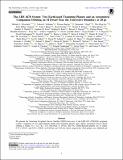The LHS 1678 System: Two Earth-sized Transiting Planets and an Astrometric Companion Orbiting an M Dwarf Near the Convective Boundary at 20 pc
Author(s)
Vanderburg, Andrew; Seager, Sara
DownloadPublished version (5.859Mb)
Publisher with Creative Commons License
Publisher with Creative Commons License
Creative Commons Attribution
Terms of use
Metadata
Show full item recordAbstract
We present the Transiting Exoplanet Survey Satellite (TESS) discovery of the LHS 1678 (TOI-696) exoplanet system, comprised of two approximately Earth-sized transiting planets and a likely astrometric brown dwarf orbiting a bright (VJ = 12.5, Ks = 8.3) M2 dwarf at 19.9 pc. The two TESS-detected planets are of radius 0.70 ± 0.04 R⊕ and 0.98 ± 0.06 R⊕ in 0.86 day and 3.69 day orbits, respectively. Both planets are validated and characterized via ground-based follow-up observations. High Accuracy Radial Velocity Planet Searcher RV monitoring yields 97.7 percentile mass upper limits of 0.35 M⊕ and 1.4 M⊕ for planets b and c, respectively. The astrometric companion detected by the Cerro Tololo Inter-American Observatory/Small and Moderate Aperture Telescope System 0.9 m has an orbital period on the order of decades and is undetected by other means. Additional ground-based observations constrain the companion to being a high-mass brown dwarf or smaller. Each planet is of unique interest; the inner planet has an ultra-short period, and the outer planet is in the Venus zone. Both are promising targets for atmospheric characterization with the James Webb Space Telescope and mass measurements via extreme-precision radial velocity. A third planet candidate of radius 0.9 ± 0.1 R⊕ in a 4.97 day orbit is also identified in multicycle TESS data for validation in future work. The host star is associated with an observed gap in the lower main sequence of the Hertzsprung–Russell diagram. This gap is tied to the transition from partially to fully convective interiors in M dwarfs, and the effect of the associated stellar astrophysics on exoplanet evolution is currently unknown. The culmination of these system properties makes LHS 1678 a unique, compelling playground for comparative exoplanet science and understanding the formation and evolution of small, short-period exoplanets orbiting low-mass stars.
Date issued
2022-04-01Department
Massachusetts Institute of Technology. Department of Physics; MIT Kavli Institute for Astrophysics and Space Research; Massachusetts Institute of Technology. Department of Earth, Atmospheric, and Planetary Sciences; Massachusetts Institute of Technology. Department of Aeronautics and AstronauticsJournal
The Astronomical Journal
Publisher
American Astronomical Society
Citation
Vanderburg, Andrew and Seager, Sara. 2022. "The LHS 1678 System: Two Earth-sized Transiting Planets and an Astrometric Companion Orbiting an M Dwarf Near the Convective Boundary at 20 pc." The Astronomical Journal, 163 (4).
Version: Final published version